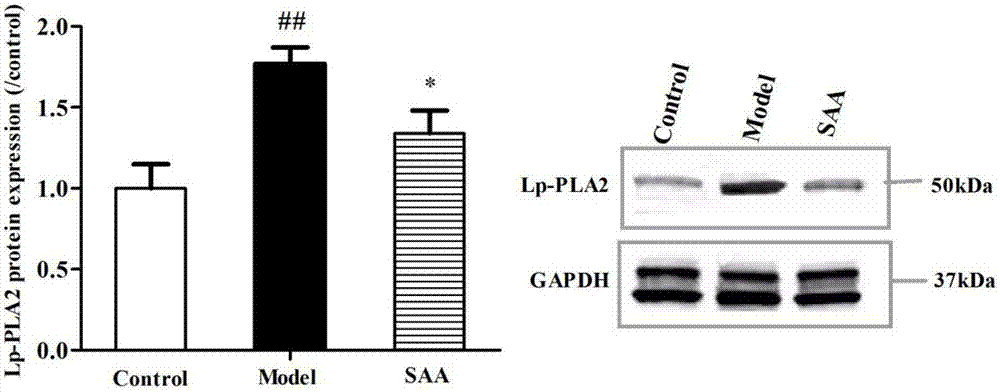New application of salvianolic acid A as lipoprotein-associated phospholipase A2 inhibitor
A technology of salvianolic acid and lipoprotein, which is applied in the field of medicine and can solve problems such as unreported research
- Summary
- Abstract
- Description
- Claims
- Application Information
AI Technical Summary
Problems solved by technology
Method used
Image
Examples
Embodiment 1
[0022] Example 1: Effect of salvianolic acid A on Lp-PLA2 content in the serum of AS rats
[0023] Materials: salvianolic acid A, vitamin D3 injection, pentobarbital sodium, rat Lp-PLA2 ELISA detection kit, platelet activating factor acetylhydrolase analysis kit.
[0024] Experimental animals: SPF grade male SD rats, 6-8 weeks old, weighing 220-250 g.
[0025] (1) Experimental method
[0026] 1. Model establishment and group administration
[0027] 1.1 Model establishment
[0028] Male SD rats were adaptively fed for 1 week and used for model preparation. They were fed with high fat (1% cholesterol, 10% lard, 10% egg yolk powder, 0.5% No. 3 bile salt, 78.5% basal feed), and at the same time Inject 400,000 IU / kg of VD3. Two weeks after VD3 injection, aortic balloon injury was performed according to the literature. Rats were intraperitoneally anesthetized with 3% sodium pentobarbital (45 mg / kg), their necks were shaved, and their backs were fixed on a mouse board. The skin...
Embodiment 2
[0038] Example 2: Effect of salvianolic acid A on the expression of Lp-PLA2 mRNA in the aorta of AS rats
[0039] Materials: salvianolic acid A, vitamin D3 injection, pentobarbital sodium, reverse transcription kit, fluorescence quantitative kit, total RNA extraction kit.
[0040] Experimental animals: SPF grade male SD rats, 6-8 weeks old, weighing 220-250 g.
[0041] (1) Experimental method
[0042]1. Model establishment and group administration
[0043] 1.1 Model establishment
[0044] Male SD rats were adaptively fed for 1 week and used for model preparation. They were fed with high fat (1% cholesterol, 10% lard, 10% egg yolk powder, 0.5% No. 3 bile salt, 78.5% basal feed), and at the same time Inject 400,000 IU / kg of VD3. Two weeks after VD3 injection, aortic balloon injury was performed according to the literature. Rats were intraperitoneally anesthetized with 3% sodium pentobarbital (45 mg / kg), their necks were shaved, and their backs were fixed on a mouse board. ...
Embodiment 3
[0053] Example 3: The effect of salvianolic acid A on the expression of Lp-PLA2 protein in the aorta of AS rats.
[0054] Materials: salvianolic acid A, vitamin D3 injection, pentobarbital sodium, Lp-PLA2 antibody
[0055] Experimental animals: SPF grade male SD rats, 6-8 weeks old, weighing 220-250 g.
[0056] (1) Experimental method
[0057] 1. Model establishment and group administration
[0058] 1.1 Model establishment
[0059] Male SD rats were adaptively fed for 1 week and used for model preparation. They were fed with high fat (1% cholesterol, 10% lard, 10% egg yolk powder, 0.5% No. 3 bile salt, 78.5% basal feed), and at the same time Inject 400,000 IU / kg of VD3. Two weeks after VD3 injection, aortic balloon injury was performed according to the literature. Rats were intraperitoneally anesthetized with 3% sodium pentobarbital (45 mg / kg), their necks were shaved, and their backs were fixed on a mouse board. The skin of the neck was disinfected with iodine, and the ...
PUM
 Login to View More
Login to View More Abstract
Description
Claims
Application Information
 Login to View More
Login to View More - R&D
- Intellectual Property
- Life Sciences
- Materials
- Tech Scout
- Unparalleled Data Quality
- Higher Quality Content
- 60% Fewer Hallucinations
Browse by: Latest US Patents, China's latest patents, Technical Efficacy Thesaurus, Application Domain, Technology Topic, Popular Technical Reports.
© 2025 PatSnap. All rights reserved.Legal|Privacy policy|Modern Slavery Act Transparency Statement|Sitemap|About US| Contact US: help@patsnap.com



